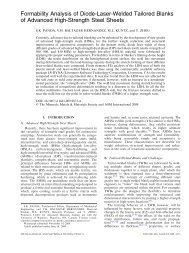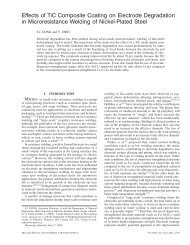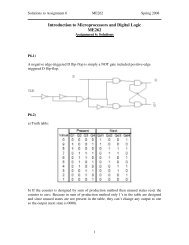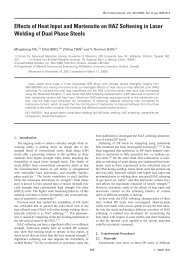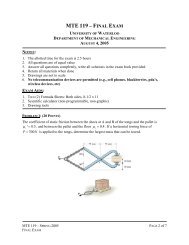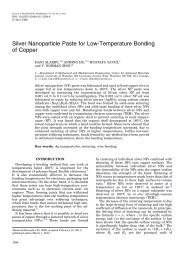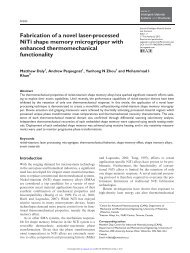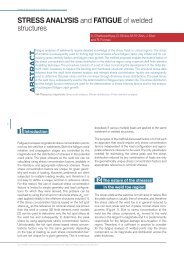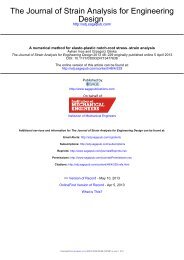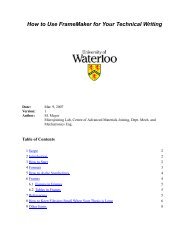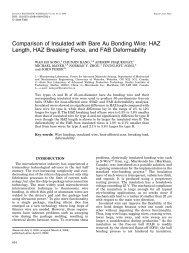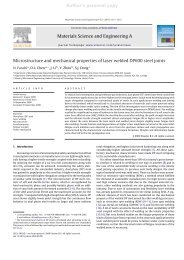Effects of oxygen contamination in the argon shielding gas in laser ...
Effects of oxygen contamination in the argon shielding gas in laser ...
Effects of oxygen contamination in the argon shielding gas in laser ...
Create successful ePaper yourself
Turn your PDF publications into a flip-book with our unique Google optimized e-Paper software.
JOURNAL OF MATERIALS SCIENCE 40 (2 005)3437 – 3443<strong>Effects</strong> <strong>of</strong> <strong>oxygen</strong> <strong>contam<strong>in</strong>ation</strong> <strong>in</strong> <strong>the</strong> <strong>argon</strong>shield<strong>in</strong>g <strong>gas</strong> <strong>in</strong> <strong>laser</strong> weld<strong>in</strong>g <strong>of</strong> commerciallypure titanium th<strong>in</strong> sheetX. LIMicrojo<strong>in</strong><strong>in</strong>g Laboratory, University <strong>of</strong> Waterloo, Waterloo, ON, Canada N2L 3G1J. XIESt. Jude Medical, CRMD, Sylmar, CA, USA 91342Y. ZHOUMicrojo<strong>in</strong><strong>in</strong>g Laboratory, University <strong>of</strong> Waterloo, Waterloo, ON, Canada N2L 3G1This work studied <strong>the</strong> effects <strong>of</strong> <strong>oxygen</strong> <strong>contam<strong>in</strong>ation</strong> <strong>in</strong> <strong>the</strong> <strong>argon</strong> shield<strong>in</strong>g <strong>gas</strong>es on weldmicrostructures and properties dur<strong>in</strong>g <strong>laser</strong> weld<strong>in</strong>g <strong>of</strong> commercially pure titanium th<strong>in</strong>sheets. The experimental results, ma<strong>in</strong>ly analyzed by optical and scann<strong>in</strong>g electronmicroscopy and mechanical test<strong>in</strong>g, have <strong>in</strong>dicated correlations between weld surfacecolour, weld microstructure and mechanical properties (strength, ductility, hardness). As<strong>the</strong> <strong>oxygen</strong> content <strong>in</strong>creased, <strong>the</strong> weld surface colour changed from silver, straw to bluewhile <strong>the</strong> surface hardness cont<strong>in</strong>ued to <strong>in</strong>crease. On <strong>the</strong> o<strong>the</strong>r hand, with <strong>the</strong> <strong>in</strong>creas<strong>in</strong>g <strong>of</strong><strong>oxygen</strong> content, <strong>the</strong> weld strength <strong>in</strong>creased first and <strong>the</strong>n decreased because <strong>the</strong>microstructure changed from ma<strong>in</strong>ly serrated alpha <strong>in</strong> welds made with pure <strong>argon</strong>shield<strong>in</strong>g <strong>gas</strong> to ma<strong>in</strong>ly acicular and platelet alpha. Practical guidel<strong>in</strong>es are also discussed,based on <strong>the</strong> study, to deal with shield<strong>in</strong>g deficiencies <strong>in</strong> <strong>laser</strong> weld<strong>in</strong>g <strong>of</strong> titanium.C○ 2005 Spr<strong>in</strong>ger Science + Bus<strong>in</strong>ess Media, Inc.1. IntroductionJo<strong>in</strong><strong>in</strong>g <strong>of</strong> titanium (Ti), ei<strong>the</strong>r commercially pure oralloyed, is <strong>of</strong>ten required <strong>in</strong> aerospace and chemical<strong>in</strong>dustries, and especially <strong>in</strong> <strong>the</strong> medical field. Ti is preferredfor manufactur<strong>in</strong>g <strong>of</strong> surgical implants and pros<strong>the</strong>ticdevices because it provides excellent comb<strong>in</strong>ations<strong>of</strong> corrosion resistance, mechanical properties andbiocompatibility [1–3]. A number <strong>of</strong> processes, suchas <strong>gas</strong> tungsten arc weld<strong>in</strong>g, <strong>laser</strong> weld<strong>in</strong>g, and braz<strong>in</strong>g[4, 5], have been used successfully to jo<strong>in</strong> Ti. Buttitanium is extremely reactive, especially <strong>in</strong> <strong>the</strong> moltenstate, and <strong>the</strong> strength and hardness <strong>of</strong> Ti welds are<strong>in</strong>creased while <strong>the</strong> ductility is reduced through pick<strong>in</strong>gup <strong>in</strong>terstitial elements, such as <strong>oxygen</strong>, nitrogen,and hydrogen, if shield<strong>in</strong>g is <strong>in</strong>adequate dur<strong>in</strong>g weld<strong>in</strong>g[6–8].A number <strong>of</strong> <strong>in</strong>vestigations have evaluated <strong>the</strong> effects<strong>of</strong> air <strong>contam<strong>in</strong>ation</strong>s (e.g., <strong>oxygen</strong> and/or nitrogen) <strong>in</strong>shield<strong>in</strong>g <strong>gas</strong>es on <strong>the</strong> weld microstructure and mechanicalproperties <strong>in</strong> <strong>gas</strong> tungsten arc weld<strong>in</strong>g (GTAW) <strong>of</strong>commercially pure (CP) Ti and Ti alloys [5, 9, 10].Most studies concluded that <strong>the</strong> colour <strong>of</strong> <strong>the</strong> weld surfacecould be used as an <strong>in</strong>dication <strong>of</strong> <strong>the</strong> degree <strong>of</strong>air <strong>contam<strong>in</strong>ation</strong> <strong>in</strong> <strong>the</strong> shield<strong>in</strong>g <strong>gas</strong>es and thus <strong>in</strong><strong>the</strong> titanium welds. For example, Maak [10], <strong>in</strong> an <strong>in</strong>vestigationon GTAW <strong>of</strong> CP grade-2 (CP-2) Ti withboth <strong>the</strong> face and root <strong>of</strong> <strong>the</strong> weld sufficiently shieldedby a specially designed jig, concluded that weld surfacediscoloration correlated to <strong>the</strong> shield<strong>in</strong>g <strong>gas</strong> deficiency,<strong>the</strong> <strong>oxygen</strong> and nitrogen content <strong>in</strong> welds, andweld metal mechanical properties. However, this correlationbetween weld surface colour and weld <strong>contam<strong>in</strong>ation</strong>depends also on o<strong>the</strong>r variables (e.g., <strong>the</strong>design <strong>of</strong> shield<strong>in</strong>g devices, weld metal cool<strong>in</strong>g rate).For example, Harwig et al. [9] found that weld colour<strong>in</strong>dicated only <strong>the</strong> surface <strong>contam<strong>in</strong>ation</strong> that occurreddur<strong>in</strong>g solid-state cool<strong>in</strong>g at high temperature, <strong>in</strong> an <strong>in</strong>vestigation<strong>in</strong> which only contam<strong>in</strong>ated shield<strong>in</strong>g <strong>gas</strong>was used <strong>in</strong> <strong>the</strong> GTAW torch but pure <strong>argon</strong> was alwaysused <strong>in</strong> back and trail shield<strong>in</strong>g. A silver weld could beproduced if a contam<strong>in</strong>ated weld pool was well shieldedafter it solidified s<strong>in</strong>ce <strong>the</strong> surface oxide can dissolve<strong>in</strong>to <strong>the</strong> substrate [9]. On <strong>the</strong> o<strong>the</strong>r hand, slower cool<strong>in</strong>grates would promote darker weld colour s<strong>in</strong>ce <strong>the</strong> weldmetal is at a higher oxidation temperature as it leaves<strong>the</strong> protection <strong>of</strong> <strong>the</strong> shield<strong>in</strong>g.Laser weld<strong>in</strong>g is an alternative to o<strong>the</strong>r processes forjo<strong>in</strong><strong>in</strong>g Ti and has a number <strong>of</strong> advantages [4, 7], suchas,• Compared to o<strong>the</strong>r fusion weld<strong>in</strong>g processes, <strong>the</strong>highly focused <strong>laser</strong> beam energy <strong>in</strong>creases weld<strong>in</strong>gspeed and hence productivity, and also requiresvery low heat <strong>in</strong>put, which reduces <strong>the</strong> possibility<strong>of</strong> damag<strong>in</strong>g surround<strong>in</strong>g <strong>the</strong>rmal-sensitive components;and0022–2461 C○ 2005 Spr<strong>in</strong>ger Science + Bus<strong>in</strong>ess Media, Inc. 3437
• No filler metal is required, as <strong>in</strong> braz<strong>in</strong>g and solder<strong>in</strong>g;<strong>the</strong>refore, biocompatibility and corrosionresistance <strong>of</strong> <strong>the</strong> base metal can be reta<strong>in</strong>ed.However, no systematic <strong>in</strong>vestigation has been publishedon effects <strong>of</strong> shield<strong>in</strong>g <strong>gas</strong> deficiency/ impurity <strong>in</strong><strong>laser</strong> weld<strong>in</strong>g <strong>of</strong> Ti, although air <strong>contam<strong>in</strong>ation</strong> rema<strong>in</strong>san issue as <strong>in</strong> o<strong>the</strong>r weld<strong>in</strong>g processes [7]. The presentwork <strong>in</strong>vestigated <strong>the</strong> effects <strong>of</strong> <strong>oxygen</strong> <strong>contam<strong>in</strong>ation</strong><strong>in</strong> <strong>the</strong> <strong>argon</strong> shield<strong>in</strong>g <strong>gas</strong> on <strong>the</strong> microstructure andproperties <strong>of</strong> <strong>laser</strong> welds <strong>of</strong> CP-2 Ti th<strong>in</strong> sheets. Thethickness <strong>of</strong> 0.5 mm <strong>of</strong> <strong>the</strong> sheets is much th<strong>in</strong>ner than<strong>the</strong> 2–3 mm material used by Harwig et al. [9].2. Experimental procedureThe material used <strong>in</strong> this study was CP-2 Ti sheet<strong>of</strong> 0.5 mm thickness <strong>in</strong> 50 × 10 mm coupons. Fullpenetrationseam welds were made us<strong>in</strong>g a LumonicsJK702H pulsed Nd:YAG <strong>laser</strong> with a 600 µm fiber opticdelivery system as bead on plate <strong>in</strong> <strong>the</strong> flat position.The <strong>laser</strong> system had a 200 mm focal length collimatorlens and a 120 mm f<strong>in</strong>al focus lens. The <strong>in</strong>tensity distribution<strong>of</strong> <strong>the</strong> <strong>laser</strong> beam at <strong>the</strong> focal po<strong>in</strong>t was found tobe well approximated by a Gaussian distribution with a1/e 2 beam diameter or “spot size”, at 413 µm [11]. Toavoid back-reflection, <strong>the</strong> <strong>laser</strong> head was aligned so that<strong>the</strong> <strong>in</strong>cident <strong>laser</strong> beam was at 15 degrees to <strong>the</strong> normal<strong>of</strong> <strong>the</strong> specimen surface. Ultra high purity <strong>argon</strong>(99.999%) and <strong>argon</strong>-<strong>oxygen</strong> mixtures, <strong>in</strong> which <strong>oxygen</strong>varied from 0 to 10 vol.%, were used as shield<strong>in</strong>g<strong>gas</strong>es <strong>in</strong> weld<strong>in</strong>g on both <strong>the</strong> top and bottom surfaces <strong>of</strong><strong>the</strong> weld. Throughout <strong>the</strong> experiments, <strong>the</strong> <strong>laser</strong> was focusedon <strong>the</strong> top surface <strong>of</strong> <strong>the</strong> material with follow<strong>in</strong>gparameters: 4.5 ms pulse width, 5 Hz pulse frequency,0.4 mm/s weld<strong>in</strong>g speed, 22–23 W average power and30 cfh (cubic feet per hour) flow rate <strong>of</strong> <strong>the</strong> shield<strong>in</strong>g<strong>gas</strong>. Weld bead surfaces were visually <strong>in</strong>spected and<strong>the</strong> discoloration was recorded.Vickers hardness tests were carried out on both <strong>the</strong>surface and cross sections <strong>of</strong> <strong>the</strong> welds us<strong>in</strong>g a load <strong>of</strong>300 g. Each data po<strong>in</strong>t was an average <strong>of</strong> six nom<strong>in</strong>allyidentical hardness impressions. It has been suggested[9, 10] that transverse tensile test<strong>in</strong>g does not providean accurate assessment <strong>of</strong> <strong>the</strong> weld strength and ductilitybecause <strong>the</strong> different strengths <strong>of</strong> <strong>the</strong> weld and basemetals <strong>of</strong>ten lead to non-uniform stra<strong>in</strong><strong>in</strong>g <strong>in</strong> <strong>the</strong> gaugelength <strong>of</strong> <strong>the</strong> test coupon. However, longitud<strong>in</strong>al allweld-metaltensile test<strong>in</strong>g was not practical <strong>in</strong> this works<strong>in</strong>ce <strong>the</strong> <strong>laser</strong> welds were very small. Instead, a speciallydesigned transverse specimen was used (Fig. 1)to concentrate <strong>the</strong> stra<strong>in</strong> <strong>in</strong> <strong>the</strong> weld metal. Tensile testswere performed us<strong>in</strong>g an INSTRON 4465 tensile testerwith a cross-head speed <strong>of</strong> 1.0 mm/m<strong>in</strong>.Figure 1 Design <strong>of</strong> tensile specimen.TABLE I Surface colour and hardness <strong>of</strong> welds made with varied<strong>oxygen</strong> content <strong>in</strong> <strong>argon</strong> shield<strong>in</strong>g <strong>gas</strong>Oxygen content (%) Surface colour Hardness (Hv)0 Silver 242 ± 110.15 Straw 246 ± 160.5 Dark Straw 247 ± 131.5 Dark Straw/Purple 254 ± 202.0 Dark Straw/ Purple/Blue 282 ± 183.0 Purple/Blue 295 ± 165.0 Blue 323 ± 1510.0 Blue 373 ± 20The welded Ti coupons were sectioned, ground, polishedand etched for exam<strong>in</strong>ation under <strong>the</strong> optical microscope.The etch<strong>in</strong>g solution was Kroll’s reagent:2mlHF,6mlHNO 3 and 92 ml H 2 O. The fracturedsurfaces <strong>of</strong> tensile tested samples were exam<strong>in</strong>ed us<strong>in</strong>ga scann<strong>in</strong>g electron microscope.3. Results and discussion3.1. Weld surface colour and hardnessTable I lists <strong>the</strong> changes <strong>in</strong> weld surface colour andhardness with <strong>in</strong>crease <strong>of</strong> <strong>oxygen</strong> content <strong>in</strong> <strong>the</strong> <strong>argon</strong>shield<strong>in</strong>g <strong>gas</strong>. The surface colour changed from silveron<strong>the</strong> welds with pure <strong>argon</strong> shield<strong>in</strong>g <strong>gas</strong>, whichis similar to <strong>the</strong> orig<strong>in</strong>al colour <strong>of</strong> <strong>the</strong> base metal, tostraw/dark straw as <strong>oxygen</strong> was <strong>in</strong>troduced <strong>in</strong>to <strong>the</strong>shield<strong>in</strong>g <strong>gas</strong>, to purple and even blue as <strong>oxygen</strong> content<strong>in</strong> <strong>the</strong> shield<strong>in</strong>g <strong>gas</strong> was greatly <strong>in</strong>creased. This observation,which was similar to most f<strong>in</strong>d<strong>in</strong>gs for GTAwelds, <strong>in</strong>dicated that <strong>the</strong> degree <strong>of</strong> discoloration <strong>of</strong> <strong>the</strong>weld surface could be related to <strong>the</strong> <strong>oxygen</strong> <strong>contam<strong>in</strong>ation</strong><strong>in</strong> <strong>the</strong> shield<strong>in</strong>g <strong>gas</strong>, s<strong>in</strong>ce <strong>the</strong> colour change wasa direct result <strong>of</strong> <strong>the</strong> change <strong>in</strong> <strong>the</strong> thickness <strong>of</strong> oxidefilm [10]. Because <strong>of</strong> <strong>the</strong> very low heat <strong>in</strong>put, <strong>the</strong> cool<strong>in</strong>grate <strong>in</strong> <strong>laser</strong> weld<strong>in</strong>g is extremely fast [12]. Thisprevents extreme oxidation after freez<strong>in</strong>g <strong>of</strong> <strong>the</strong> weldbecause <strong>the</strong> temperature <strong>of</strong> <strong>the</strong> weld and heat affectedzone drops very fast. However, it should be cautioned touse <strong>the</strong> discoloration as an <strong>in</strong>spection tool <strong>of</strong> <strong>the</strong> shield<strong>in</strong>gdeficiency because <strong>the</strong> color sequence (from straw,purple to blue) repeats itself as <strong>the</strong> oxidation thickness<strong>in</strong>creases [13].For <strong>the</strong> GTA welds made with contam<strong>in</strong>ated shield<strong>in</strong>g<strong>gas</strong>, <strong>the</strong> microhardness <strong>of</strong> welds <strong>in</strong>creased from 165to 225 Hv as <strong>oxygen</strong> equivalent <strong>of</strong> weld metal <strong>in</strong>creasedfrom 0 to 0.29 wt% [9]. The hardness <strong>of</strong> welds wasfound to depend on <strong>the</strong> content <strong>of</strong> <strong>oxygen</strong> <strong>in</strong> <strong>the</strong> weldmetal as well as on o<strong>the</strong>r factors. The 3 mm thick weldshad a microhardness that was approximately 5 Hv lowerthan <strong>the</strong> 2 mm thick welds as a function <strong>of</strong> <strong>oxygen</strong>equivalent, apparently due to <strong>the</strong> lower cool<strong>in</strong>g rate.However, <strong>the</strong> equivalent formula was not found to beapplicable to <strong>the</strong> data <strong>of</strong> <strong>laser</strong> weld<strong>in</strong>g. In that previouswork [9], <strong>the</strong> maximum hardness was only 225Hv for <strong>the</strong> GTA welds, even lower than <strong>the</strong> value <strong>of</strong>242 Hv obta<strong>in</strong>ed under high purity Argon shield<strong>in</strong>g<strong>gas</strong> <strong>in</strong> <strong>laser</strong> weld<strong>in</strong>g. The effect <strong>of</strong> cool<strong>in</strong>g rate on <strong>the</strong>microhardness <strong>of</strong> <strong>the</strong>se welds is significant, and <strong>the</strong> f<strong>in</strong>alhardness result depends on <strong>the</strong> <strong>in</strong>teraction <strong>of</strong> cool<strong>in</strong>grate with <strong>the</strong> composition <strong>in</strong>clud<strong>in</strong>g O and N contents.3438
Figure 2 Cross sections <strong>of</strong> (a) base metal and (b) weld made with pure <strong>argon</strong> shield<strong>in</strong>g <strong>gas</strong>.Figure 3 Cross sections <strong>of</strong> welds made with various <strong>oxygen</strong> content <strong>in</strong> <strong>argon</strong> shield<strong>in</strong>g <strong>gas</strong>.The <strong>in</strong>crease <strong>in</strong> <strong>oxygen</strong> content also <strong>in</strong>creased <strong>the</strong>surface hardness from 242 Hv on welds with pure <strong>argon</strong>shield<strong>in</strong>g <strong>gas</strong>, to 373 Hv when <strong>the</strong> <strong>oxygen</strong> content was10%. These data may be compared to <strong>the</strong> hardness <strong>of</strong>191 Hv found on <strong>the</strong> surface <strong>of</strong> <strong>the</strong> base metal. This<strong>in</strong>crease <strong>in</strong> hardness as <strong>the</strong> <strong>oxygen</strong> content <strong>in</strong>creasedwas due to both <strong>in</strong>creased surface oxide film thicknessand <strong>in</strong>creased <strong>oxygen</strong> diffused <strong>in</strong>to <strong>the</strong> surface layer <strong>of</strong><strong>the</strong> weld. Therefore, surface hardness could be a good<strong>in</strong>dication <strong>of</strong> <strong>the</strong> <strong>gas</strong> shield<strong>in</strong>g deficiency.3.2. Weld structures and propertiesFig. 2 shows <strong>the</strong> microstructures <strong>of</strong> <strong>the</strong> base (2a) andweld metal (2b) with pure <strong>argon</strong> shield<strong>in</strong>g <strong>gas</strong>. Theweld<strong>in</strong>g <strong>the</strong>rmal cycle when us<strong>in</strong>g pure <strong>argon</strong> shield<strong>in</strong>g<strong>gas</strong> changed <strong>the</strong> base metal microstructure fromequiaxed alpha <strong>of</strong> relatively uniform gra<strong>in</strong> size (averageabout 10–15 µm) to a mixed coarse-gra<strong>in</strong>ed serratedalpha and a smaller amount <strong>of</strong> f<strong>in</strong>e-gra<strong>in</strong>ed acicularalpha (Fig. 2b, po<strong>in</strong>ted by arrow S and A). Addition<strong>of</strong> <strong>oxygen</strong> (up to 0.5–1.0%) <strong>in</strong> <strong>the</strong> <strong>argon</strong> shield<strong>in</strong>g <strong>gas</strong>3439
Figure 4 Hardness pr<strong>of</strong>iles along <strong>the</strong> cross section <strong>of</strong> weld made with10% <strong>oxygen</strong> content.Figure 5 Weld hardness versus <strong>oxygen</strong> content <strong>in</strong> <strong>argon</strong> shield<strong>in</strong>g <strong>gas</strong>.reduced both gra<strong>in</strong> size and amount <strong>of</strong> <strong>the</strong> serrated alpha,and <strong>in</strong>creased <strong>the</strong> amount <strong>of</strong> acicular and plateletalpha (Fig. 3a, po<strong>in</strong>ted by arrow S, A and P). As <strong>the</strong> <strong>oxygen</strong>content cont<strong>in</strong>ued to <strong>in</strong>crease (above 1.5–2.0%),weld microstructure was dom<strong>in</strong>ated by <strong>the</strong> acicular andplatelet alpha. At very high <strong>oxygen</strong> content, <strong>the</strong> alphaplatelets formed <strong>in</strong> colonies, giv<strong>in</strong>g a basketweave appearance(Fig. 3d).The significant changes <strong>in</strong> weld microstructures because<strong>of</strong> <strong>in</strong>creased <strong>oxygen</strong> content were not observed <strong>in</strong>GTAW <strong>of</strong> commercially pure Ti <strong>in</strong> which serrated andacicular alpha [9, 10] were <strong>the</strong> typical constituents at <strong>in</strong>creased<strong>oxygen</strong> contents [9, 10]. There are two possiblereasons for this discrepancy between GTAW and <strong>laser</strong>weld<strong>in</strong>g. First, <strong>the</strong> range <strong>of</strong> <strong>oxygen</strong> content covered <strong>in</strong>those GTAW studies was relatively narrower, with air<strong>contam<strong>in</strong>ation</strong> up to 2% [10], compared to <strong>the</strong> <strong>oxygen</strong><strong>contam<strong>in</strong>ation</strong> up to 10% <strong>in</strong> this work. Second, <strong>the</strong>microstructural change <strong>in</strong> <strong>laser</strong> weld<strong>in</strong>g is much moresensitive to <strong>the</strong> <strong>oxygen</strong> content because <strong>of</strong> <strong>the</strong> muchfaster cool<strong>in</strong>g rates compared to those <strong>in</strong> GTAW. Forexample, typical cool<strong>in</strong>g rates <strong>in</strong> <strong>laser</strong> weld<strong>in</strong>g rangefrom hundreds to thousands <strong>of</strong> degrees centigrade persecond (comparable to those <strong>in</strong> water quench<strong>in</strong>g) whilethose <strong>in</strong> GTAW are <strong>in</strong> <strong>the</strong> range <strong>of</strong> tens <strong>of</strong> degrees centigradeper second [12]. In fact, it has been suggested thatalpha prime (martensite alpha) may be present <strong>in</strong> commerciallypure Ti and Ti-6Al-4V <strong>laser</strong> welds because<strong>of</strong> low heat <strong>in</strong>put and rapid cool<strong>in</strong>g by <strong>the</strong> surround<strong>in</strong>gcold material [7]. Comparative studies <strong>of</strong> near alpha andalpha-beta Ti alloys us<strong>in</strong>g GTAW, and <strong>laser</strong> and electronbeam weld<strong>in</strong>g, have <strong>in</strong>dicated that <strong>the</strong> phase transformation<strong>in</strong> welds changes from diffusion-controllednucleation and growth, to martensitic mechanisms ascool<strong>in</strong>g rates <strong>in</strong>crease [12, 14].The hardness varied across <strong>the</strong> weld region because<strong>oxygen</strong> diffused <strong>in</strong>to weld metal through <strong>the</strong> surfacesand <strong>the</strong> <strong>oxygen</strong> content was higher near surfaces comparedto <strong>the</strong> centre (Fig. 4). Therefore, <strong>the</strong> average value(from three, two and one <strong>in</strong>dentations <strong>in</strong> weld regionrespectively at locations 1, 2 and 3 as shown <strong>in</strong> Fig. 4)was plotted <strong>in</strong> Fig. 5 for <strong>the</strong> effect <strong>of</strong> <strong>oxygen</strong> content.The hardness <strong>of</strong> <strong>the</strong> weld metal with pure <strong>argon</strong> shield<strong>in</strong>g<strong>gas</strong> was 209 Hv, which compared to that <strong>of</strong> <strong>the</strong> basemetal at 173 Hv. The <strong>oxygen</strong> content <strong>in</strong>creased <strong>the</strong> weldhardness all <strong>the</strong> way to 317 Hv for <strong>the</strong> weld with 10%<strong>oxygen</strong>, which came from both microstructural changeand absorbed and diffused <strong>oxygen</strong> <strong>in</strong> <strong>the</strong> weld metal,as <strong>in</strong>dicated by Wang and Welsch [5]. It is <strong>in</strong>terest<strong>in</strong>gto note <strong>the</strong> large <strong>in</strong>crease <strong>of</strong> hardness <strong>of</strong> <strong>the</strong> welds withpure <strong>argon</strong> shield<strong>in</strong>g <strong>gas</strong> over <strong>the</strong> base metal, which isopposite to <strong>the</strong> observation that GTAW bead-on-platewelds with low <strong>oxygen</strong> content were s<strong>of</strong>ter than <strong>the</strong> CP-2Tibase metal [9]. The difference <strong>in</strong> hardness changeis believed to be caused by <strong>the</strong> different cool<strong>in</strong>g ratesbetween GTAW and <strong>laser</strong> weld<strong>in</strong>g, similar to <strong>the</strong> difference<strong>in</strong> weld microstructure <strong>of</strong> GTAW and <strong>laser</strong> welds.In fact, Harwig [9] also noted that <strong>the</strong> extent <strong>of</strong> welds<strong>of</strong>ten<strong>in</strong>g became smaller as <strong>the</strong> cool<strong>in</strong>g rate <strong>in</strong>creased.Fig. 6 shows <strong>the</strong> effect <strong>of</strong> <strong>oxygen</strong> content on <strong>the</strong> tensilestrength <strong>of</strong> <strong>the</strong> welds. The <strong>oxygen</strong> content <strong>in</strong>creased<strong>the</strong> strength from 594 MPa for <strong>the</strong> welds with pure <strong>argon</strong>shield<strong>in</strong>g (compared to 592 MPa for <strong>the</strong> base metal)to about 620–630 MPa when <strong>the</strong> <strong>oxygen</strong> content wasFigure 6 Weld tensile strength versus <strong>oxygen</strong> content <strong>in</strong> <strong>argon</strong> shield<strong>in</strong>g<strong>gas</strong>.3440
Figure 7 Load-displacement curves for welds made with various <strong>oxygen</strong>contents.about 2–3%. However, as <strong>the</strong> <strong>oxygen</strong> content cont<strong>in</strong>uedto <strong>in</strong>crease, <strong>the</strong> weld strengths started to decreaseand eventually became even lower than that <strong>of</strong> <strong>the</strong> basemetal (Fig. 6). This was not surpris<strong>in</strong>g, s<strong>in</strong>ce <strong>the</strong> tensilespecimen geometry shown <strong>in</strong> Fig. 1 causes a substantialstra<strong>in</strong> concentration at <strong>the</strong> edge notches, which shouldcause early crack <strong>in</strong>itiation <strong>in</strong> <strong>the</strong> lower ductility weldsmade with high <strong>oxygen</strong> content. The resultant reducedmaximum force associated with low overall stra<strong>in</strong> is<strong>in</strong>dicated <strong>in</strong> <strong>the</strong> typical load-displacement curves <strong>in</strong>Fig. 7.Generally, <strong>the</strong> tensile fractures <strong>in</strong>itiated at <strong>the</strong> notchand crossed <strong>the</strong> three areas <strong>in</strong>clud<strong>in</strong>g weld, fusion l<strong>in</strong>eand base metal (Fig. 8). Weld metal showed less ductilebehaviour, especially when <strong>the</strong> <strong>oxygen</strong> content washigh. Fig. 9 shows <strong>the</strong> typical fracture surfaces <strong>of</strong> <strong>the</strong>welds (<strong>in</strong> <strong>the</strong> weld zone <strong>in</strong> Fig. 8) made with various<strong>oxygen</strong> contents <strong>in</strong> <strong>the</strong> shield<strong>in</strong>g <strong>gas</strong>. While <strong>the</strong> basemetal fractured <strong>in</strong> a ductile manner with classical dimplemorphology, <strong>the</strong> fracture <strong>of</strong> <strong>the</strong> welds made withpure <strong>argon</strong> shield<strong>in</strong>g <strong>gas</strong> was similar to that <strong>of</strong> <strong>the</strong> basemetal but <strong>in</strong>cluded some locations with less ductile features(Fig. 10). The <strong>in</strong>troduction <strong>of</strong> <strong>oxygen</strong> <strong>in</strong>to <strong>the</strong>shield<strong>in</strong>g <strong>gas</strong> greatly reduced <strong>the</strong> ductility by replac<strong>in</strong>g<strong>the</strong> ductile dimple structure with relatively brittlequasi-cleavage morphology. When <strong>the</strong> <strong>oxygen</strong> contentwas high (e.g., at 10% <strong>in</strong> Fig. 9d), <strong>the</strong>re were little signs<strong>of</strong> plastic deformation, with <strong>the</strong> fracture path appear<strong>in</strong>gto be <strong>in</strong>tergranular along colony boundaries or cleavageacross colonies, which <strong>in</strong>dicates that <strong>the</strong> fracturemode changed completely from ductile to brittle. Thiswas very similar to an <strong>in</strong>vestigation on <strong>the</strong> effects <strong>of</strong><strong>oxygen</strong> on mechanical properties <strong>of</strong> an alpha titaniumalloy Ti-6Al-2V, <strong>in</strong> which <strong>oxygen</strong> caused a change fromgood ductility at low <strong>oxygen</strong> concentration (0.07 wt%)to total brittleness at high 0.65 wt% [15].3.3. Shield<strong>in</strong>g <strong>gas</strong> deficiency andmechanical property requirementsThe above experimental results have <strong>in</strong>dicated correlationsbetween weld surface color, and weldFigure 8 Fracture surfaces at various locations <strong>of</strong> a weld made with 10% <strong>oxygen</strong> content.3441
Figure 9 Fracture surfaces <strong>of</strong> welds made with various <strong>oxygen</strong> content <strong>in</strong> <strong>argon</strong> shield<strong>in</strong>g <strong>gas</strong>.Figure 10 Fracture surfaces <strong>of</strong> (a) base metal and (b) weld made with pure <strong>argon</strong> shield<strong>in</strong>g <strong>gas</strong>.microstructure and mechanical properties (strength,ductility, hardness). But <strong>the</strong> question rema<strong>in</strong>s as to whatlevel <strong>of</strong> <strong>oxygen</strong> <strong>contam<strong>in</strong>ation</strong> would be acceptable dur<strong>in</strong>g<strong>laser</strong> weld<strong>in</strong>g <strong>of</strong> Ti.For structural weld<strong>in</strong>g, AWS D10.6-91 [9] suggeststhat a satisfactory weld should have a hardness that doesnot exceed <strong>the</strong> base metal hardness by 5 R B (which isequivalent to about 30 Hv). The ASME Boiler and PressureVessel Code Division 1, Section VIII [10] also suggeststhat a weld hardness <strong>in</strong>crease over <strong>the</strong> base metal<strong>of</strong> more than 40 Br<strong>in</strong>nel hardness number (which isequivalent to about 40 Hv <strong>in</strong> <strong>the</strong> range <strong>of</strong> hardness valuesconsidered for Ti welds) <strong>in</strong>dicates excessive weld<strong>contam<strong>in</strong>ation</strong>. But, <strong>in</strong> this work, <strong>the</strong> welds with pure<strong>argon</strong> shield<strong>in</strong>g <strong>gas</strong> had already a hardness <strong>in</strong>creaseover base metal <strong>of</strong> about 36 Hv.3442
Ano<strong>the</strong>r commonly used hardness standard for Tiwelds suggests a maximum weld hardness <strong>of</strong> 250 Hv[10]. This would translate <strong>in</strong>to an acceptable <strong>oxygen</strong>content up to 2% <strong>in</strong> Fig. 5, which appears to be consistentwith <strong>the</strong> shield<strong>in</strong>g <strong>oxygen</strong> content at 1.5–2%that caused significant changes <strong>in</strong> weld microstructureand fracture surface morphologies (Fig. 9). However,any acceptable levels <strong>of</strong> <strong>oxygen</strong> <strong>contam<strong>in</strong>ation</strong> <strong>in</strong> <strong>the</strong>shield<strong>in</strong>g <strong>gas</strong> would also depend on how much <strong>oxygen</strong>could be absorbed <strong>in</strong>to weld metal and how fast <strong>the</strong>weld would cool down from high temperature. Fur<strong>the</strong>rwork is needed to study <strong>the</strong> effects <strong>of</strong> <strong>oxygen</strong> <strong>contam<strong>in</strong>ation</strong>under different weld<strong>in</strong>g conditions, suchas heat <strong>in</strong>put, sheet thickness, and jo<strong>in</strong>t and fixturedesign.4. SummaryThis work <strong>in</strong>vestigated <strong>the</strong> effects <strong>of</strong> <strong>oxygen</strong> <strong>contam<strong>in</strong>ation</strong><strong>in</strong> <strong>the</strong> <strong>argon</strong> shield<strong>in</strong>g <strong>gas</strong> on weld microstructuresand properties dur<strong>in</strong>g <strong>laser</strong> weld<strong>in</strong>g <strong>of</strong> commerciallypure titanium th<strong>in</strong> sheets. The experimental results,ma<strong>in</strong>ly analyzed by optical and scann<strong>in</strong>g electron microscopyand mechanical test<strong>in</strong>g, have <strong>in</strong>dicated correlationsbetween weld surface color, weld microstructureand mechanical properties (strength, ductility, hardness).The ma<strong>in</strong> conclusions <strong>in</strong>clude:• Weld surface colour changed from silver to darkblue as <strong>the</strong> <strong>oxygen</strong> content <strong>in</strong> <strong>argon</strong> shield<strong>in</strong>g <strong>gas</strong><strong>in</strong>creased from 0 to 10% but may not be a good<strong>in</strong>dication <strong>of</strong> <strong>the</strong> shield<strong>in</strong>g deficiency because <strong>the</strong>color sequence would repeat itself as <strong>the</strong> oxidationthickness <strong>in</strong>creases. On <strong>the</strong> o<strong>the</strong>r hand, weld surfacehardness, while <strong>in</strong>creased as <strong>the</strong> <strong>oxygen</strong> content<strong>in</strong>creased and also correlated to weld metalhardness, could be a better <strong>in</strong>spection tool <strong>of</strong> <strong>the</strong>shield<strong>in</strong>g deficiency.• Addition <strong>of</strong> <strong>oxygen</strong> <strong>in</strong> <strong>the</strong> shield<strong>in</strong>g <strong>gas</strong>, whilereduc<strong>in</strong>g coarse-gra<strong>in</strong>ed serrated alpha, <strong>in</strong>creasedf<strong>in</strong>er gra<strong>in</strong>ed acicular and platelet alpha <strong>in</strong> weldmetal. When <strong>the</strong> <strong>oxygen</strong> content was above 1.5%,weld metal was dom<strong>in</strong>ated by acicular and plateletalpha. As <strong>the</strong> <strong>oxygen</strong> content cont<strong>in</strong>ued to <strong>in</strong>crease,<strong>the</strong> alpha platelets occurred <strong>in</strong> colonies, giv<strong>in</strong>g abasketweave appearance.• As <strong>the</strong> <strong>oxygen</strong> content <strong>in</strong>creased, weld metalstrength <strong>in</strong>creased first and <strong>the</strong>n started to dropwhen <strong>the</strong> <strong>oxygen</strong> content was above 2%. This wasapparently caused by <strong>the</strong> occurrence <strong>of</strong> brittle fractureas a result <strong>of</strong> <strong>the</strong> formation <strong>of</strong> acicular andplatelet alpha.References1. ASM Handbook, Propert. Select.: Nonferr. Alloys Spec.-Purp.Mater. 2 (1990) 586.2. J. GEDOPT and E. DELARBRE, Proc. SPIE 4088 (2000) 264.3. S. SHRIVASTAVA, Medical Device Materials, 8–10 September2003, Anaheim CA, <strong>in</strong> Proceed<strong>in</strong>gs <strong>of</strong> <strong>the</strong> Materials and Processesfor Medical Devices Conference, p. 417.4. J. LIU, I. WATANABE, K. YOSHIDA and M. ATSUTA,Dental Mater. 18 (2000) 143.5. R. R. WANG and G. E. WELSCH J. Prosth. Dent. 74(5) (1995)521.6. J. C. BORLAND, Brit. Weld. J. February (1961) 61.7. T. YAMAGISHI, M. ITO and Y. FUJIMURA, J. Prosth.Dent. 70(3) (1993) 264.8. H. W. A. WISKOTT, T. DOUMAS, S.S. SCHERRER andU. C. BELSER, J. Mater. Sci.: Mater. Med. 12 (2001) 719.9. D. D. HARWIG, C. FOUNTAIN, W. ITTIWATTANA andH. CASTNER, Weld. J. Weld. Res. Nov. Suppl. (2000) 305s.10. P. Y. Y. MAAK, The Effect <strong>of</strong> Air Contam<strong>in</strong>ation <strong>in</strong> <strong>the</strong> ArgonShield<strong>in</strong>g Gas on <strong>the</strong> Mechanical Properties <strong>of</strong> Titanium Gas-Tungsten-Arc Welds, TR-282, Scientific Document Distribution Office(SDDO), Atomic Energy <strong>of</strong> Canada Limited, Chalk River, Ontario,K0J 1J0, July 1984.11. E. BIRO, D. C. WECKMAN and Y. ZHOU, Metall. Mater.Trans. A 33A (2002) 2019.12. W. A. BAESLACK III and F. D. MULLINS, J. Mater. Sci.Lett. 1 (1982) 371.13. J. TALKINGTON, D. HARWIG, H. CASTNER and G.MITCHELL, Weld. J. March (2000), 35.14. K. K. MURTHY and S. SUNDARESAN, J. Mater. Sci. 33(1998) 817.15. Z. LIU and G. WELSCH, Metallu. Trans. A 19A (1988) 527.Received 5 October 2004and accepted 7 February 20053443



